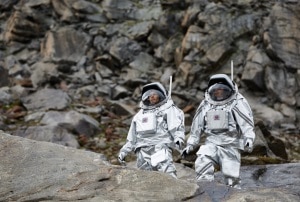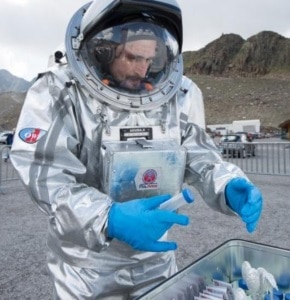Austrian Glacier Serves As Site for Mars Simulation
[caption id="attachment_2645" align="alignright" width="300"] Analog astronauts walking on a glacier in Austria (source: Österreichisches Weltraum Forum/Flickr).
Analog astronauts walking on a glacier in Austria (source: Österreichisches Weltraum Forum/Flickr).
A manned mission to Mars is one step closer to becoming a reality thanks to a remote glacier in western Austria known mostly for its surrounding ski slopes and snow-capped mountain vistas.
This post was originally posted last year on the GlacierHub.org by Ashley Chappo.
The Kaunertal Glacier, located in the Tyrol state of Austria, recently served as a field site to test a mission of human researchers on Mars. A report detailing the findings of the analog mission was published in Acta Astronautica in September by Gernot Groemer, et al. The AMADEE-15 mission, coordinated by the Austrian Space Forum and 19 partner nations, lasted for 12 days in August 2015, during which a carefully chosen team of researchers performed selected experiments under realistic Martian surface conditions.
But the glacier mission was not just a bunch of scientists playing pretend in an obscure area of the world: Real-life workflows of a true space mission were conducted to aid future astronauts who may one day set foot on the Red Planet.
[caption id="attachment_2648" align="alignleft" width="290"] Simulating the collection of soil samples on Mars, at a field station on Kaunertal Glacier in Austria.
Simulating the collection of soil samples on Mars, at a field station on Kaunertal Glacier in Austria.
The Kaunertal Glacier experiments conducted during the nearly two-week simulation represented no small feat. The success of the experiments relied on a 88-member team whose primary ambition was to advance mission support strategies and further the public visibility of analog planetary research essential to future Martian exploration.
Other field simulations, prior to the AMADEE-15 mission, have been conducted around the world in areas that reflect Martian conditions. These missions have taken place in locations as diverse as the Sahara desert in Morocco and ice caves in Austria.
In fact, glaciers can make excellent test sites for Earth-based Mars missions due to their “astrobiological and mission architectural relevance,” according to Gernot Groemer, et al. Glacier-like forms found on Mars, which are similar to some of Earth’s rock glaciers, represent a key area of study as they could be extremely important to any chance of future human life on the Red Planet. Glaciers are a source of water and ice, which can serve as both a source of life-support for humans and a habitat for other life-forms, such as terrestrial microbes.
[caption id="attachment_2647" align="alignright" width="300"] Location of the Kaunertal Valley in Austria.
Location of the Kaunertal Valley in Austria.
It was the Austrian glacier’s accessibility, while remote, that made it a prime candidate for an Earth-based test mission like the AMADEE-15, according to Gernot Groemer, et al. The area in which the Kaunertal Glacier is located has good road proximity, accessible by a toll road which rises approximately 2,750 m. In addition, the ice and rock glaciers of the Kaunertal Valley offered a terrain representative of the planetary surface and rock glaciers of Mars, where there is a high percentage of water ice.
While any Mars analog cannot be exact, the conditions of the simulation were crafted to represent the logistics of a Mars mission, with the construction of a realistic base station for the field test located in a parking lot along the toll road at 2800 m. Researchers also calculated 10-minute adjustments for real-time communication between astronauts and the Operations Station. To make the simulation stronger, the AMADEE-15 exercise relied on two space simulators and four robotic and aerial vehicles.
Günther Platter, Governor of Tirol, said that the Austrian Space Forum chose the Kaunertal glacier region for fieldwork to find “important insights for future manned missions to Mars.”
[caption id="attachment_2646" align="alignleft" width="300"] Photo of the Flight Control Room of AMADEE-15 mission at Kaunertal Glacier in Austria (source: Acta Astronautica).
Photo of the Flight Control Room of AMADEE-15 mission at Kaunertal Glacier in Austria (source: Acta Astronautica).
These manned missions to Mars have been a dream of the international aerospace community since the 1960s when the United States successfully completed its first flyby mission with the robotic interplanetary probe named the Mariner 4.
On Tuesday, October 11, President Barack Obama reiterated in an opinion piece for CNN that the United States has made strides toward its goal to send humans to Mars by the 2030s, a timeline shared by other nations. An even larger ambition of the aerospace field is to have humans remain on Mars for an extended period, perhaps ultimately settling on the planet.
A crucial piece to meeting these timelines and space goals involves completing successful Earth-based Martian missions like the AMADEE-15 on Kaunertal Glacier. The mission proved essential for the understanding of workflow requirements for human-robotic Mars missions due to take place within the next few decades.
The Mars simulation in the Austrian Kaunertal Valley region goes to show that glaciers can be key not only to the understanding of life on our own increasingly warming planet, but also to the success of future Martian colonies.
 Analog astronauts walking on a glacier in Austria (source: Österreichisches Weltraum Forum/Flickr).
Analog astronauts walking on a glacier in Austria (source: Österreichisches Weltraum Forum/Flickr).A manned mission to Mars is one step closer to becoming a reality thanks to a remote glacier in western Austria known mostly for its surrounding ski slopes and snow-capped mountain vistas.
This post was originally posted last year on the GlacierHub.org by Ashley Chappo.
The Kaunertal Glacier, located in the Tyrol state of Austria, recently served as a field site to test a mission of human researchers on Mars. A report detailing the findings of the analog mission was published in Acta Astronautica in September by Gernot Groemer, et al. The AMADEE-15 mission, coordinated by the Austrian Space Forum and 19 partner nations, lasted for 12 days in August 2015, during which a carefully chosen team of researchers performed selected experiments under realistic Martian surface conditions.
But the glacier mission was not just a bunch of scientists playing pretend in an obscure area of the world: Real-life workflows of a true space mission were conducted to aid future astronauts who may one day set foot on the Red Planet.
[caption id="attachment_2648" align="alignleft" width="290"]
 Simulating the collection of soil samples on Mars, at a field station on Kaunertal Glacier in Austria.
Simulating the collection of soil samples on Mars, at a field station on Kaunertal Glacier in Austria.The Kaunertal Glacier experiments conducted during the nearly two-week simulation represented no small feat. The success of the experiments relied on a 88-member team whose primary ambition was to advance mission support strategies and further the public visibility of analog planetary research essential to future Martian exploration.
Other field simulations, prior to the AMADEE-15 mission, have been conducted around the world in areas that reflect Martian conditions. These missions have taken place in locations as diverse as the Sahara desert in Morocco and ice caves in Austria.
In fact, glaciers can make excellent test sites for Earth-based Mars missions due to their “astrobiological and mission architectural relevance,” according to Gernot Groemer, et al. Glacier-like forms found on Mars, which are similar to some of Earth’s rock glaciers, represent a key area of study as they could be extremely important to any chance of future human life on the Red Planet. Glaciers are a source of water and ice, which can serve as both a source of life-support for humans and a habitat for other life-forms, such as terrestrial microbes.
[caption id="attachment_2647" align="alignright" width="300"]
 Location of the Kaunertal Valley in Austria.
Location of the Kaunertal Valley in Austria.It was the Austrian glacier’s accessibility, while remote, that made it a prime candidate for an Earth-based test mission like the AMADEE-15, according to Gernot Groemer, et al. The area in which the Kaunertal Glacier is located has good road proximity, accessible by a toll road which rises approximately 2,750 m. In addition, the ice and rock glaciers of the Kaunertal Valley offered a terrain representative of the planetary surface and rock glaciers of Mars, where there is a high percentage of water ice.
While any Mars analog cannot be exact, the conditions of the simulation were crafted to represent the logistics of a Mars mission, with the construction of a realistic base station for the field test located in a parking lot along the toll road at 2800 m. Researchers also calculated 10-minute adjustments for real-time communication between astronauts and the Operations Station. To make the simulation stronger, the AMADEE-15 exercise relied on two space simulators and four robotic and aerial vehicles.
Günther Platter, Governor of Tirol, said that the Austrian Space Forum chose the Kaunertal glacier region for fieldwork to find “important insights for future manned missions to Mars.”
[caption id="attachment_2646" align="alignleft" width="300"]
 Photo of the Flight Control Room of AMADEE-15 mission at Kaunertal Glacier in Austria (source: Acta Astronautica).
Photo of the Flight Control Room of AMADEE-15 mission at Kaunertal Glacier in Austria (source: Acta Astronautica).These manned missions to Mars have been a dream of the international aerospace community since the 1960s when the United States successfully completed its first flyby mission with the robotic interplanetary probe named the Mariner 4.
On Tuesday, October 11, President Barack Obama reiterated in an opinion piece for CNN that the United States has made strides toward its goal to send humans to Mars by the 2030s, a timeline shared by other nations. An even larger ambition of the aerospace field is to have humans remain on Mars for an extended period, perhaps ultimately settling on the planet.
A crucial piece to meeting these timelines and space goals involves completing successful Earth-based Martian missions like the AMADEE-15 on Kaunertal Glacier. The mission proved essential for the understanding of workflow requirements for human-robotic Mars missions due to take place within the next few decades.
The Mars simulation in the Austrian Kaunertal Valley region goes to show that glaciers can be key not only to the understanding of life on our own increasingly warming planet, but also to the success of future Martian colonies.
Related Posts
By accepting you will be accessing a service provided by a third-party external to https://mountainresearchinitiative.org/






